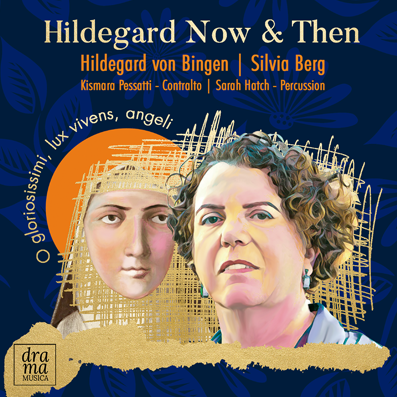
HILDEGARD NOW & THEN
Hildegard von Bingen & Silvia Berg
KISMARA PESSATTI
SARAH HATCH
DRAMA009
HILDEGARD NOW & THEN
As much as we know about Hildegard of Bingen, a German Benedictine abbess who set up her own monastery on the banks of the Rhine and became famous for her religious thinking and visions, there are so many questions we may never answer. This, in part, is what makes her music at once fascinating and mysterious. First, did she herself write the ethereal, soaring chants attributed to her? She lived long before the modern idea of a composer, or indeed an artist of any kind, had taken hold. That would only happen centuries later. Art in the 12th century was made to serve God. The individual maker’s name was rarely known.
Hildegard’s music might have been a collaborative process, between herself and her nuns. It’s possible that Hildegard initiated a melody, in her own distinctive way, and someone else wrote it down. Was she, and is she, as we encounter on this disc in the music of Silvia Berg, primarily an inspiration? These are matters to ponder, as are all the variants of preparing music for the daily liturgy in a cloistered religious dwelling, when we listen to the remarkable body of works associated with her: 75 ‘symphoniae’ , known as the Symphonia armonie celestium revelationum (The Symphony of the Harmony of Celestial Revelations), and a sacred morality drama, Ordo Virtutum. Her predominant subjects are the Holy Trinity and the Virgin Mary, angels, the living light, local saints and, above all, God’s creation of humanity. The rich language of her texts is vividly informed by her own taxonomies of plants, trees, animals, fish, precious stones and minerals (in written works such as Physica, or Causae et Curae).
Hildegard was born in 1098 in the village of Bermersheim, in the Alzey-Worms district in the Rheinland Palatinate of Germany. She was, as far as we can tell, the tenth child of a comfortably prosperous family, given as a tithe by her parents to the church, a common habit at the time. Perhaps as young as eight, perhaps in early adolescence, she went to live as an anchorite alongside the monks of Disibodenberg, in the charge of a slightly older woman, Jutta von Sponheim.
Only much later, at the start of her fifth decade, did Hildegard find her own creative and intellectual voice, setting up a monastery, writing theological tracts, communicating with popes, bishops and emperors, fighting against corruption in the Church, her thoughts often shaped by the visions which had been central to her life since childhood. Described as ‘the sybil of the Rhine’, and known far beyond her native land, Hildegard died in her Rupertsberg monastery in 1179. At the time of her death, witnesses recorded, a ‘manifest miracle’ occurred. Two arcs of brilliant colour appeared in the sky, broadening to the fours corners of the earth, and the moon was full. Immediately revered as a saint, Hildegard of Bingen was officially canonised in 2012.
© FIONA MADDOCKS, 2019
Fiona Maddocks is the author of Hildegard of Bingen; the woman of her age (Faber)
